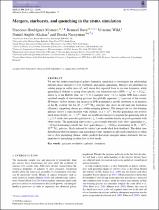| dc.contributor.author | Montero, Francisco Rodr´ıguez | |
| dc.contributor.author | Wild, Vivienne | |
| dc.contributor.author | Dave, Romeel | |
| dc.date.accessioned | 2022-12-05T10:50:07Z | |
| dc.date.available | 2022-12-05T10:50:07Z | |
| dc.date.issued | 2019-07-29 | |
| dc.identifier.citation | Davé, R., et al. (2019). Mergers, starbursts, and quenching in the simba simulation, Monthly Notices of the Royal Astronomical Society, Volume 490, Issue 2, December 2019, Pages 2139–2154, https://dx.doi.org/10.1093/mnras/stz2580 | en_US |
| dc.identifier.uri | http://hdl.handle.net/10566/8219 | |
| dc.description.abstract | We use the SIMBAcosmological galaxy formation simulation to investigate the relationship
between major mergers ( 4:1), starbursts, and galaxy quenching. Mergers are identified via
sudden jumps in stellar mass M∗ well above that expected from in situ star formation, while
quenching is defined as going from specific star formation rate (sSFR) > t
−1
H to < 0.2t
−1
H ,
where tH is the Hubble time. At z ≈ 0–3, mergers show ∼2–3× higher SFR than a massmatched
sample of star-forming galaxies, but globally represent 1 per cent of the cosmic
SF budget. At low masses, the increase in SFR in mergers is mostly attributed to an increase
in the H2 content, but for M∗ 1010.5M mergers also show an elevated star formation
efficiency suggesting denser gas within merging galaxies. The merger rate for star-forming
galaxies shows a rapid increase with redshift, ∝(1 + z)3.5, but the quenching rate evolves
much more slowly, ∝(1 + z)0.9; there are insufficient mergers to explain the quenching rate at
z 1.5. SIMBA first quenches galaxies at z 3, with a number density in good agreement with
observations. The quenching time-scales τ q are strongly bimodal, with ‘slow’ quenchings (τ q
∼ 0.1tH) dominating overall, but ‘fast’ quenchings (τ q ∼ 0.01tH) dominating in M∗ ∼ 1010–
1010.5M galaxies, likely induced by SIMBA’s jet-mode black hole feedback. The delay time
distribution between mergers and quenching events suggests no physical connection to either
fast or slow quenching. Hence, SIMBA predicts that major mergers induce starbursts, but are
unrelated to quenching in either fast or slow mode. | en_US |
| dc.language.iso | en | en_US |
| dc.publisher | MNRAS | en_US |
| dc.subject | galaxies: evolution | en_US |
| dc.subject | galaxies: formation | en_US |
| dc.title | Mergers, starbursts, and quenching in the SIMBA simulation | en_US |
| dc.type | Article | en_US |

